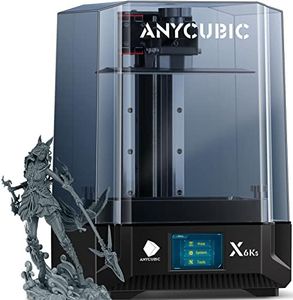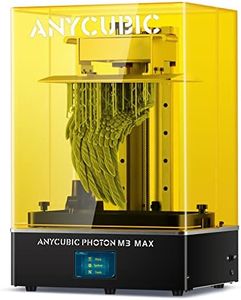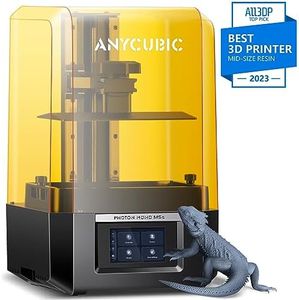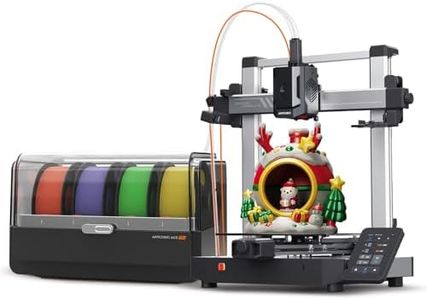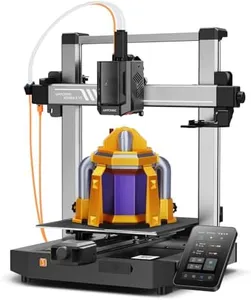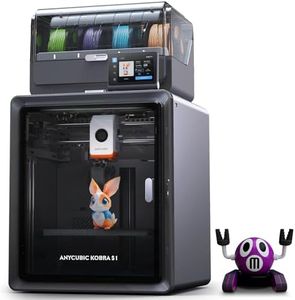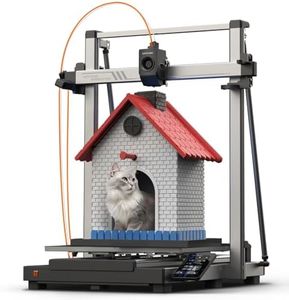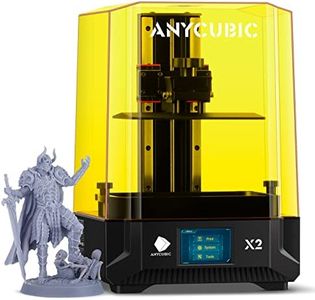6 Best SLA Printers 2025 in the United States
Our technology thoroughly searches through the online shopping world, reviewing hundreds of sites. We then process and analyze this information, updating in real-time to bring you the latest top-rated products. This way, you always get the best and most current options available.

Our Top Picks
Winner
ANYCUBIC Photon Mono X 6Ks, Resin 3D Printer with 9.1'' 6K Mono Screen, LCD SLA Resin Printer with Upgraded LighTurbo Matrix, Large Print Volume 7.7'' x 4.8'' x 7.8''
Most important from
433 reviews
The ANYCUBIC Photon Mono X 6Ks is a resin 3D printer designed for users who want high-detail prints and a relatively large build volume. Its standout feature is the 9.1-inch 6K monochrome screen, offering a sharp resolution of 5760 x 3600 pixels, which means your prints will capture fine details and smooth surfaces. The upgraded LighTurbo Matrix light source ensures even curing with minimal layer lines, helping produce cleaner models faster, at speeds up to 60 mm/hour.
The printer’s build volume is quite generous at about 7.7 x 4.8 x 7.8 inches, giving room to print multiple smaller models at once or larger pieces without splitting them. The dual-linear Z-axis rail and wear-resistant components enhance printing stability, reducing the chance of layer shifting or warping. This stability, combined with a laser-engraved platform, improves adhesion for better print success. Anycubic’s updated slicing software is user-friendly and free, simplifying preparing your files and increasing print reliability with repair functions. The printer supports a wide range of standard resins, which adds flexibility for different projects.
Like most resin printers, post-processing involves cleaning and curing the prints manually, which can be time-consuming and requires safety precautions. The printer weighs around 11 pounds and is moderately sized, so it fits well on a hobbyist’s desk but might need some space for post-processing tools. It is well-suited for hobbyists and small businesses looking for high-quality resin prints with a good balance of speed and detail, although beginners should be prepared for the learning curve in handling resin and post-processing steps.
Most important from
433 reviews
phrozen Sonic Mighty 8K LCD Resin 3D Printer, 10" Monochrome LCD, Tabletop 3D Resin Printer with 28µm XY Resolution, 8.6 * 4.8 * 9.3 Inch Printing Volume for Models, Miniatures and Action Figures
Most important from
210 reviews
The Phrozen Sonic Mighty 8K LCD Resin 3D Printer stands out with its impressive 8K resolution, ensuring that even larger prints retain exceptionally sharp details. This makes it highly suitable for users who need high-resolution prints, such as designers and architects. Its substantial build volume of L21.8 x W12.3 x H23.5 cm allows for the creation of larger models or multiple smaller models simultaneously, enhancing productivity.
The laser power and resin compatibility are robust, supporting various resin types which provide flexibility for different printing projects. Print speed is efficient, further boosted by the 10” monochrome LCD screen that has a longer lifespan, which means more consistent performance over time. The dual linear rails and frosted laser cut building plate reduce wobbling and enhance the success rate of prints, giving users more reliable output and less frustration from failed prints.
Ease of use is underscored by the Phrozen GO app, which enables remote control of the printer, although limited to one account per printer which might be a drawback for collaborative environments. However, the printer does require post-processing, which is typical for resin prints but adds an extra step for users. Despite its powerful capabilities, it maintains a compact footprint, making it suitable for various workspaces. The Phrozen Sonic Mighty 8K is a strong contender in the SLA printer category, particularly for users who prioritize high resolution, reliability, and flexibility in resin compatibility, though they should be prepared for the necessary post-processing steps.
Most important from
210 reviews
phrozen Sonic Mini 8K S LCD Resin 3D Printer, 7.1" Monochrome LCD, Tabletop 3D Resin Printer with 22µm XY Resolution, 6.5 * 2.8 * 6.7 Inch Printing Volume for Models, Miniatures and Action Figures
Most important from
131 reviews
The Phrozen Sonic Mini 8K S LCD Resin 3D Printer stands out for its exceptionally high print resolution of 22 µm, which ensures that the printed models are precise and detailed, making it ideal for intricate designs. With a build volume of L16.5 x W7.2 x H17 cm, it is suitable for small to medium-sized projects. The 7.1” Mono LCD Screen contributes to faster printing speeds and longevity. Additionally, it supports a wide range of resin types, providing versatility in material choices.
The printer's open-source system compatibility with popular slicers like Lychee, Chitubox, and Tango enhances the ease of use and customization options, which is beneficial for both beginners and experienced users. Its straightforward operation and affordable price make it a great entry-level option for novices in 3D printing.
However, the compact build volume might not be sufficient for larger projects, and post-processing requirements, such as cleaning and curing, are common for resin printers and can be time-consuming. At 22 pounds, it is relatively heavy, which could be a drawback for users with limited space or those who need a portable device. Despite these drawbacks, its high resolution and smooth surface printing capabilities are significant strengths, making it a worthwhile investment for detailed and high-quality prints.
Most important from
131 reviews
Buying Guide for the Best SLA Printers
When choosing an SLA (Stereolithography) printer, it's important to consider several key specifications to ensure you get the best fit for your needs. SLA printers use a laser to cure liquid resin into hardened plastic, which allows for high precision and detailed prints. Understanding the key specifications will help you make an informed decision based on your specific requirements and intended use cases.FAQ
Most Popular Categories Right Now


